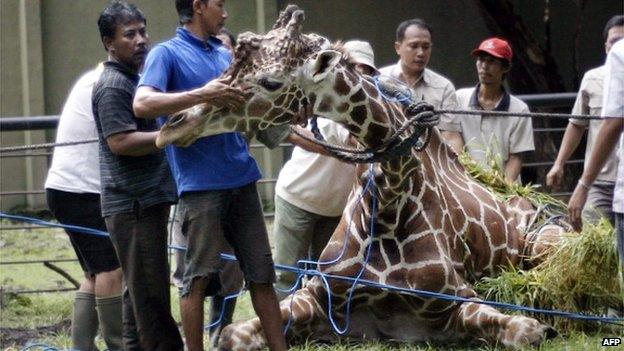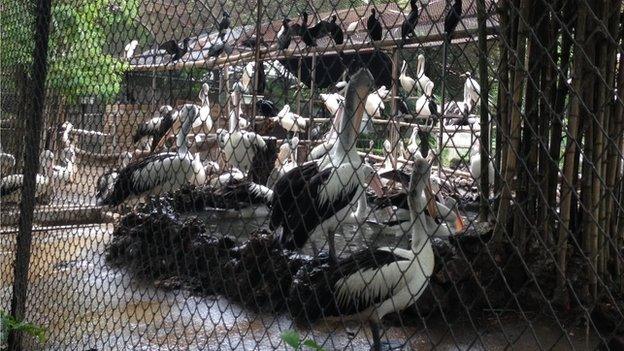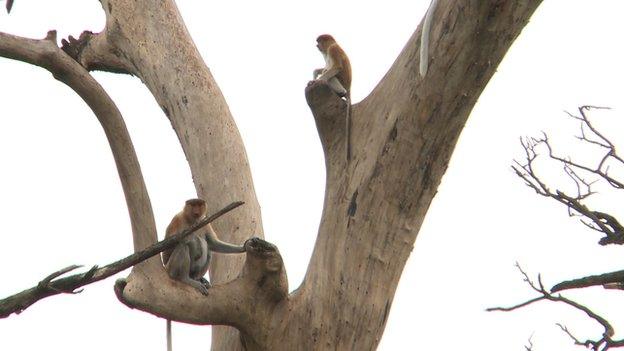Can Indonesia's 'zoo of death' turn things around?
- Published
Alice Budisatrijo looks at the conditions at Surabaya zoo
Last month, a young lion named Michael was found hanged in his cage at Surabaya zoo.
The 18-month-old got his neck tangled in a cable used by keepers to open and close his cage.
An official claimed the lion got himself caught as he jumped around.
However, by the time the police arrived, the lion's carcass had been removed from the cage, complicating any investigation into whether negligence contributed to his death.
Zoo director Ratna Achjuningrum said keepers did not realise they should wait for police.
"They did not think that it was potentially a crime scene that needed to be sealed off," she said.
Surabaya zoo, on the island of Java, is Indonesia's oldest - and home to thousands of animals, birds and other creatures.
In recent months, however, it has been dubbed "the zoo of death" because of the number of animals dying from malnutrition, disease and neglect.

The World Association of Zoos and Aquariums has written to Surabaya zoo expressing concern
A few days before Michael's death, a wildebeest was found dead in its cage. A few days later, a young mountain goat died of neck injuries. Zoo officials said it was attacked by an adult goat.
And in March 2012, 20kg (44 pounds) of plastic were found in the stomach of a dead giraffe.
In the 1970s the zoo was South East Asia's largest, with more species than anywhere else in the region.
Today it has a total of 3,465 animals from 201 species living within its walls.
But far from being a statistic it should be proud of, activists say overpopulation - along with lack of funding and expertise - are urgent problems for management to address.

Officials say the aviary is not overpopulated - but say they plan to expand it
Entering the park, crowds of noisy black-furred gibbons known as siamang play, sleep and eat on an island. Nearby, pelicans and herons are crammed into an aviary measuring about 180 sq m (1,940 sq ft).
Veterinarian Liang Kaspe, the zoo's head of operations, says the cage is big enough for the 86 pelicans inside.
"There is no overpopulation here," she said. "They need to live in big groups in order to breed."
"We have a plan to expand this cage," she added.
'Urgent action'
In a row of enclosures surrounded by a moat, dozens of long-tailed macaques roamed around in packs. At least 10 of them had babies attached to their stomachs like marsupials.
Dr Liang acknowledged that there was a surplus of macaques, but said the zoo could not reduce the population because it could not find any place to take them.
"It's not that easy to move these animals, because we need to think about their lives when they're out of this zoo," she said.
"It's not like having a cow or a cat that you can sell or give to other people if you don't want them anymore."
But other experts say urgent action is needed.
The World Association of Zoos and Aquariums (Waza), a group that includes 300 leading zoos and aquariums as its members, deems the animal welfare conditions in Surabaya so appalling that its leader has written two letters to Indonesian President Susilo Bambang Yudhoyono in the past two months.
In one of the letters, Waza Executive Director Gerald Dick said the situation in Surabaya was "becoming more than a single zoo issue".

The zoo says it has been successful in breeding Komodo dragons
He suggested that the conditions in Surabaya could threaten the reputation of all zoos, which often face criticism from groups that oppose keeping animals in captivity.
Last month Mr Yudhoyono finally stepped in. In front of journalists, the Indonesian leader said that his wife "never slept" because of the barrage of messages on social media that she received about the zoo.
After he met officials, the central government formally gave Surabaya Mayor Tri Rismaharini full authority to manage the zoo.
'Difficult decision'
The move is expected to put a stop to the infighting and frequent changes in management that have taken place in recent years.
In 2010, as conditions deteriorated, the central government asked experienced zookeeper Tony Sumampau to temporarily run the zoo - then funded by admission fees and external fundraising.
Ms Rismaharini took it over last year, amid deepening problems, but zoo management has not been part of the city budget until now.
Mr Sumampau said he doubted whether the city government would succeed on its own in improving the animals' welfare.
"As long as they change most of the staff and the management, and they have a professional to help them run the zoo, I think it can happen," he said.

Proboscis monkeys live on an island with several barren trees
"But this is a very difficult political decision. If the mayor wants to spend money, she can rebuild the zoo. But she is not going to be a mayor forever, and that is why most government zoos in Indonesia are not in good condition."
Back at the zoo, Director Ratna Achjuningrum rejected the notion that the Surabaya zoo had become a national shame.
"We have many successes, for example we've been successful in breeding Komodos, and in providing a place for proboscis monkeys that resembles their natural habitat."
The endangered primates she referred to came from the mangrove, riverine and swamp forests in the island of Kalimantan, also known as Borneo.
I pointed out that the island where the proboscis monkeys lived in the zoo had several dead trees.
"Of course there are still shortcomings, but we will improve them," Ms Ratna said.
- Published18 March 2013
- Published22 March 2011